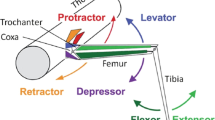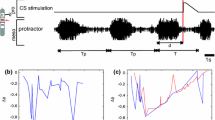Abstract
A model of interleg coordination presented in a separate report is evaluated here by perturbing the step pattern in three ways. First, when the initial leg configuration is varied, the simulated leg movements assume a stable coordination from natural starting configurations in a natural way (Fig. 1a). They also rapidly re-establish the normal coordination when started from unnatural configurations (Fig. 1b-d). An explicit hierarchy of natural frequencies for the legs of the three thoracic segments is not required. Second, when the coordination is perturbed by assigning one or more legs a retraction velocity different from the rest, gliding coordination or various integer step ratios can be produced (Figs. 2–4). Third, when the swing of one leg is obstructed, characteristic changes in the stepping of other legs occur (Fig. 5). Overall differences between the step patterns of the model and those of the stick insect are related to the form of the coordinating mechanisms. Errors made by the model, such as overlapping swings by adjacent legs or discrepancies in step timing and step end-points, point out the limitations of a model restricted to kinematic parameters.
Similar content being viewed by others
Abbreviations
- AEP and iAEP:
-
actual and intrinsic anterior extreme position
- PEP and iPEP:
-
actual and intrinsic posterior extreme position
References
Cruse H (1979) A new model describing the coordination pattern of the legs of a walking stick insect. Biol Cybern 32:1–7
Cruse H (1983) The influence of load and leg amputation upon coordination in walking crustaceans: a model calculation. Biol Cybern 49:119–125
Cruse H (1985) Coactivating influences between neighbouring legs in walking insects. J Exp Biol 114:513–519
Cruse H (1990) What mechanisms coordinate leg movement in walking arthropods? TINS 13:15–21
Cruse H, Epstein S (1982) Peripheral influences on the movement of the legs in a walking insect Carausius morosus. J Exp Biol 101:161–170
Dean J (1991a) A model of leg coordination in the stick insect, Carausius morosus. I. Geometrical consideration of contralateral and ipsilateral coordination mechanisms between two adjacent legs. Biol Cybern 64:393–402
Dean J (1991b) A model of leg coordination in the stick insect, Carausius morosus. II. Description of the kinematic model and simulation of normal step patterns. Biol Cybern 64:403–411
Dean J, Wendler G (1982) Stick insects walking on a wheel: perturbations induced by obstruction of leg protraction. J Comp Physiol 148:195–207
Dean J, Wendler G (1983) Stick insect locomotion on a walking wheel: interleg coordination of leg position. J Exp Biol 103:75–94
Dean J, Wendler G (1984) Stick insects walking on a wheel: patterns of starting and stopping. J Exp Biol 110:203–216
Foth E, Bässler U (1985a) Leg movements of stick insects walking with five legs on a treadwheel and with one leg on a motor-driven belt, I. General results and 1∶1-coordination. Biol Cybern 51:313–318
Foth E, Bässler U (1985b) Leg movements of stick insects walking with five legs on a treadwheel and with one leg on a motor-driven belt. II. Leg coordination when step-frequencies differ from leg to leg. Biol Cybern 51:319–324
Foth E, Graham D (1983a) Influence of loading parallel to the body axis on the walking coordination of an insect. 1. Ipsilateral effects. Biol Cybern 47:17–23
Foth E, Graham D (1983b) Influence of loading parallel to the body axis on the walking coordination of an insect. 2. Contralateral effects. Biol Cybern 47:17–23
Graham D (1983) Insects are both impeded and propelled by their legs during walking. J Exp Biol 104:129–137
Wendler G (1968) Ein Analogmodell der Beinbewegungen eines laufenden Insekts. In: Marko H, Faerber G (eds) Kybernetik 1968. Oldenbourg, Muenchen Wien, pp 68–74
Wendler G (1978) Locomotion: das Ergebnis zentral-peripherer Interaktion. Verh Dtsch Zool Ges 71:80–96
Author information
Authors and Affiliations
Rights and permissions
About this article
Cite this article
Dean, J. A model of leg coordination in the stick insect, Carausius morosus . Biol. Cybern. 66, 335–343 (1992). https://doi.org/10.1007/BF00203670
Received:
Accepted:
Issue Date:
DOI: https://doi.org/10.1007/BF00203670




